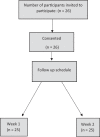The effect of inflammation management on pH, temperature, and bacterial burden
- PMID: 36251505
- PMCID: PMC10031221
- DOI: 10.1111/iwj.13970
The effect of inflammation management on pH, temperature, and bacterial burden
Abstract
The aim of this feasibility study was to investigate the impact of inflammation management on wound pH, temperature, and bacterial burden, using the principles of TIME and Wound Bed Preparation. A quantitative non-comparative, prospective, descriptive observational design. Following ethical approval, 26 participants with 27 wounds of varying aetiologies were observed twice weekly for 2 weeks. Wounds were treated with cleansing, repeated sharp debridement, and topical cadexomer iodine. Wound pH (pH indicator strips), temperature (infrared camera), bacterial burden (fluorescence imaging) and size (ruler method) was monitored at each visit. The mean age of all participants was 47 years (SD: 20.3 years), and 79% (n = 19) were male, and most wounds were acute (70%; n = 19) and included surgical and trauma wounds, the remaining (30%; n = 8) were chronic and included vascular ulcers and non-healing surgical wounds. Mean wound duration was 53.88 days (SD: 64.49 days). Over the follow up period, pH values ranged from 6 to 8.7, temperature (centre spot) ranged from 28.4°C to 36.4°C and there was an average 39% reduction in wound size. Inflammation management had a positive effect on pH, temperature, bacterial burden, and wound size. This study demonstrated that it was feasible to practice inflammation management using a structured approach to enhance wound outcomes.
Keywords: MolecuLight; time; wound assessment; wound pH; wound temperature.
© 2022 The Authors. International Wound Journal published by Medicalhelplines.com Inc (3M) and John Wiley & Sons Ltd.
Conflict of interest statement
The MolecuLight™ i:X fluorescence imaging device was given at no charge, but the drapes were purchased.
Figures


Similar articles
-
Wound pH and temperature as predictors of healing: an observational study.J Wound Care. 2023 May 2;32(5):302-310. doi: 10.12968/jowc.2023.32.5.302. J Wound Care. 2023. PMID: 37094930
-
Associations Among Skin Surface pH, Temperature, and Bacterial Burden in Wounds.Adv Skin Wound Care. 2020 Apr;33(4):180-185. doi: 10.1097/01.ASW.0000655488.33274.d0. Adv Skin Wound Care. 2020. PMID: 32195721
-
A novel debridement device for the treatment of hard-to-heal wounds: a prospective trial.J Wound Care. 2021 May 1;30(Sup5):S32-S36. doi: 10.12968/jowc.2021.30.Sup5.S32. J Wound Care. 2021. PMID: 33979231 Clinical Trial.
-
Wound cleansing for treating venous leg ulcers.Cochrane Database Syst Rev. 2021 Mar 10;3(3):CD011675. doi: 10.1002/14651858.CD011675.pub2. Cochrane Database Syst Rev. 2021. PMID: 33734426 Free PMC article.
-
Efficacy of topical cadexomer iodine treatment in chronic wounds: Systematic review and meta-analysis of comparative clinical trials.Int Wound J. 2021 Oct;18(5):586-597. doi: 10.1111/iwj.13560. Epub 2021 Feb 8. Int Wound J. 2021. PMID: 33559332 Free PMC article.
Cited by
-
Towards Intelligent Wound Care: Hydrogel-Based Wearable Monitoring and Therapeutic Platforms.Polymers (Basel). 2025 Jul 6;17(13):1881. doi: 10.3390/polym17131881. Polymers (Basel). 2025. PMID: 40647892 Free PMC article. Review.
-
The Clinical Utility of Autofluorescence Imaging for Bacterial Detection in Wounds: A Systematic Review.Int Wound J. 2025 Jun;22(6):e70678. doi: 10.1111/iwj.70678. Int Wound J. 2025. PMID: 40432492 Free PMC article.
-
Glucose oxidase: An emerging multidimensional treatment option for diabetic wound healing.Bioact Mater. 2024 Oct 15;44:131-151. doi: 10.1016/j.bioactmat.2024.10.006. eCollection 2025 Feb. Bioact Mater. 2024. PMID: 39484022 Free PMC article. Review.
-
Intelligent electrospinning nanofibrous membranes for monitoring and promotion of the wound healing.Mater Today Bio. 2024 May 18;26:101093. doi: 10.1016/j.mtbio.2024.101093. eCollection 2024 Jun. Mater Today Bio. 2024. PMID: 38818528 Free PMC article. Review.
-
Autofluorescence properties of wound-associated bacteria cultured under various temperature, salinity, and pH conditions.BMC Microbiol. 2025 Aug 15;25(1):511. doi: 10.1186/s12866-025-04200-3. BMC Microbiol. 2025. PMID: 40817211 Free PMC article.
References
-
- Vowden P, Vowden K. The economic impact of hard‐to‐heal wounds: promoting practice change to address passivity in wound management. Wounds Int. 2016;7:10‐15.
-
- Gethin G. The importance of continous measuring. Wounds UK. 2006;2:60‐68.
-
- Wendelken ME, Berg WT, Lichtenstein P, Markowitz L, Comfort C, Alvarez OM. Wounds measured from digital photographs using photodigital planimetry software: validation and rater reliability. Wounds. 2011;23:267‐275. - PubMed
Publication types
MeSH terms
Grants and funding
LinkOut - more resources
Full Text Sources

